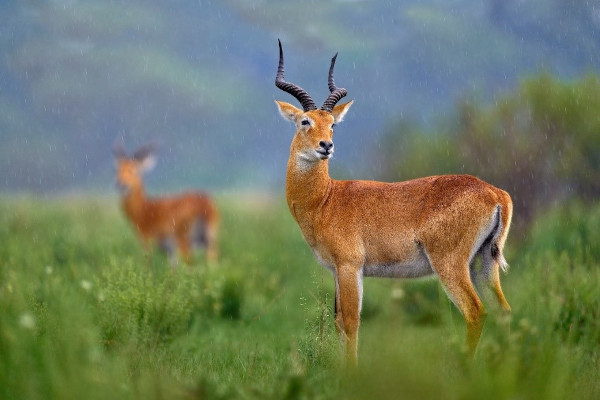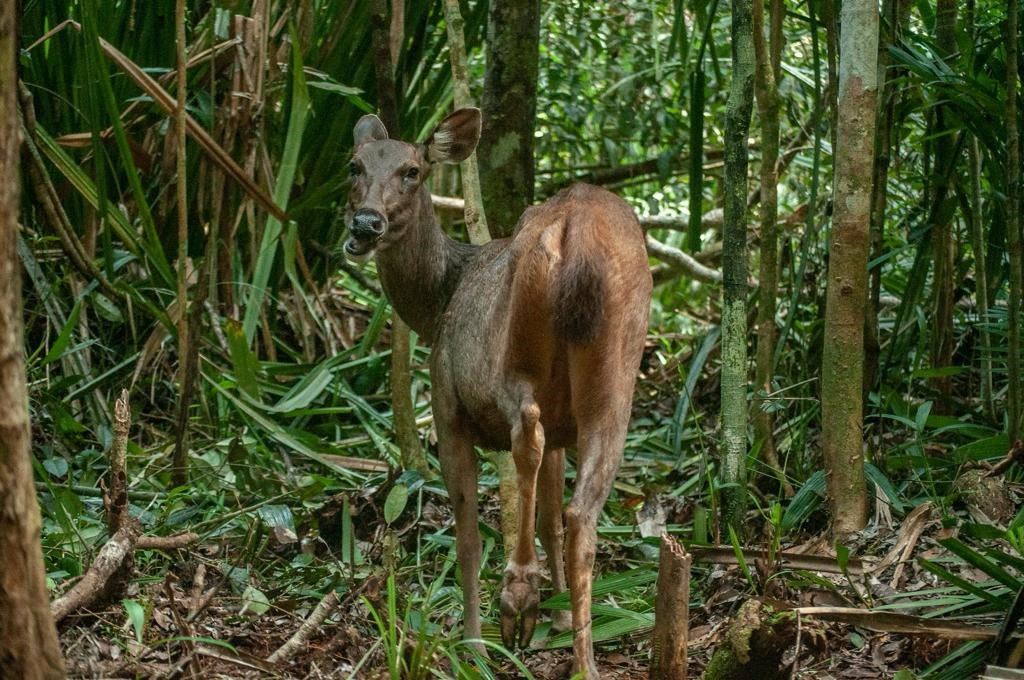December 20, 2023
The Kampar Peninsula is home to a spectacular array of species, from big cats and butterflies to rare birds, reptiles, and herds of deer. This forest is managed and maintained by Restorasi Ekosistem Riau (RER), one of the biggest and most important restoration projects in the world.
With its dense forest, grasslands and freshwater lakes, RER is the ideal place for deer. In this article, we’ll look closer at this group and explore some of the key differences between them and their closest relatives.
Ever wondered what’s the difference between antelope and deer? RER has the answers.
1. Taxonomy
Antelopes belong to the Bovidae family, made up of sheep, goats and cattle; whereas deer are members of the Cervidae family, which includes muntjac, elk, red and fallow deer, reindeer, roe deer, and moose.
Both deer and antelope are hoofed animals (known as ‘ungulates’). They are also ruminant mammals, which means they have multiple stomachs. This allows them to swallow food and then bring it back up for a second munch – a process known as ‘chewing cud’.
Antelope are indigenous to most of Africa, India, the Middle East, Central Asia, and parts of Eastern Europe, while deer originally come from the Northern Hemisphere, but are now native to Europe, Asia, North America and South America.
2. Physical appearance
Do you know the difference between horns and antlers? If so, you can also tell antelope and deer apart. Basically, antlers are temporary – they are shed and regrown every year for the mating season. Horns are permanently attached and continue to grow throughout an animal’s life.

Pretty much all ungulates are sporting some kind of head gear. But as their family tree branches out, the differences become clear: Deer, elk, moose, and other Cervidae have antlers; while Bovidae like antelope, buffalo and other cattle have horns.
Antelope horns come in all shapes and sizes, from elaborate curves and coils to long, pointed spears and tiny stubs. The most impressive belong to the markhor: these mountain goats have horns like enormous corkscrews, which can grow up to 160 cm (63 in) in the males, and up to 25 cm (10 in) in females.
And that’s another key difference between deer and antelopes: Unlike deer, where only the males grow antlers, horns can be seen in the females of around two-thirds of all antelope species.
3. Size comparison
So who’s the biggest? When it comes to physical appearance, antelope vary greatly in size. Some of the largest, like a male common eland, can be 180 cm at the shoulder and weigh nearly a ton (2,000 lbs.). At the other end of the spectrum, the diminutive royal antelope is only 24 cm tall and weighs about as much as a pineapple.
Deer, on the other hand (or hoof), can be huge. The biggest is the moose, which stands a massive 2.6 meters (8 ft 6 in) tall and can weigh up to 800 kg. To sum up, there’s plenty of size variation in both families, but the biggest of all belongs to the antelopes.
4. Habitat
Antelopes are native to Africa and Eurasia, where some species roam the grassy plains on huge migrations in search of food. Deer can be found on every continent except Antarctica and Australia and live in a range of habitats, from tundra to tropical rainforest. They tend to have a more varied diet, eating nuts, fruits, wild soybeans, corn, buds and bark, whereas antelope graze more exclusively on grass, with occasional nibbles of tree shoots, fallen leaves, and juicy plants.
5. Speed
Wherever they live and whatever they eat, deer and antelopes are likely to be on the menu for large predators. When your species has spent millions of years and countless generations escaping lions, cheetahs, and bears, this makes you pretty fast. Antelopes can reach speeds of up to 50 miles per hour, and run over long distances. Deer can clock speeds of around 35 miles per hour, but can only do so in short bursts. Both groups’ running abilities reflect their surroundings and the power of their predators.
Deer conservation in RER
One of the many species recorded in RER is the sambar deer (Rusa unicolor), known in Indonesia as ‘Rusa sambar’. Like most deer, the males of this species grow large antlers for the rutting season. Adults can be 160 cm (63 in) tall and weigh as much as 546 kg (1,204 lbs.). Sambar deer prefer the dense cover of forests, deciduous shrublands and grasses, and generally like to be close to water, where they feel safe from predators. Their home ranges are wide, spanning 1,500 hectares for males and 300 for females.

On the Kampar Peninsula, 344,573 hectares of peat forest provide food, shelter and room to roam for a thriving population of sambar deer. They in turn keep the forest healthy, grazing on plants, dispersing seeds in their droppings and providing a reliable source of food for the Sumatran tigers that share their home. Together, these species form an integral link in the web of life at RER; a diverse and thriving ecosystem, where the natural wonders of Indonesia are preserved.
Last August, on National Nature Conservation Day, RER welcomed four new sambar deer to the Kampar Peninsula, following the release of two females and two males relocated from the Meranti Islands. To read more, check out this article.